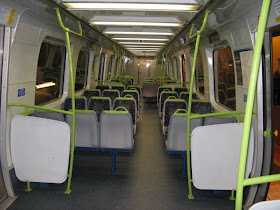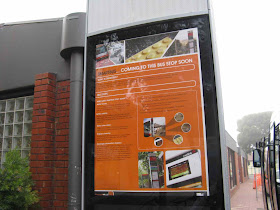How to wreck a bus route: How 624 and 627 happened
Bus routes 624 and 627, operating in Melbourne's south-east, encapsulate the strengths and weaknesses of Melbourne's bus network. Their strengths include coverage of residential streets, service to railway stations and links to shopping centres. Weaknesses include confusing routes, inconsistent deviations, duplication with other services and limited days and operating hours (mostly 627 but also a portion of 624).
Apart from school children and seniors patronage on both routes is low. Peak services can be quiet despite opportunities presented by high rail patronage, limited parking and significant housing away from a railway station. The routes themselves are now incomprehensible, with successive changes (expedient at the time) making them worse. In this post I will describe what happened and the prospects that exist for improvement.
Brief Description
624 and 627 fall within the cities of Monash, Stonnington, Glen Eira and Boroondara and are part of their local bus service reviews. The notes below, written over the current Metlink maps, identify areas for improvement and were part of a submission to the current bus reviews.


The above notes speak for themselves and need no elaboration. Rather the purpose of this post is to document how the above routes got so twisted and illegible.
Having no timetables from this era, I'll use the route descriptions and maps in old Melway directories. Melway started inclucing bus routes from circa 1980 and has included them in most editions since (1987 and 1990 are the exceptions).
The evolution of Route 624
At one time what is now 624 operated close to what it should be, ie as seperate and fairly direct local routes with one or at most two clear purposes.
In 1982 coverage was provided via three distinct routes, as follows:
622: Holmesglen - Oakleigh - Chadstone (like part of current 624 but with Chadstone appended to Oakleigh end, not Holmesglen end)
625: Chadstone - Dandenong Rd - Neerim Rd - Caulfield - Kew East (Carnegie portion of 624)
620: Chadstone - Dandenong Rd - Caulfield - Burke Rd - Gardiner - Carnegie - McKinnon (part of current 627 and Darling Rd section of 624)
622 was a three-quarter circle so might not appeal to the purist. Nevertheless it has trip generators at each end, provided needed local coverage and was unlikely to confuse anyone.
625 was an L-shaped route. There was some duplication with 623 (addressed in 2007 when 624 moved to Neerim Rd) but it's fairly direct with two clear purposes.
620 was perhaps the least legible of the three as it appears to form a large loop around Caulfield and Malvern East. It serves areas near Carnegie twice, was an indirect way to McKinnon from Chadstone and had no Brighton east connection. However it gave some direct links not available now and allowed 627 to operate as a legible route from Elsternwick to Chadstone via Ormond and Oakleigh. Evidence of Route 620 remains at an untouched stop flag near Arawatta Street, Carnegie.
1984's Melway saw some changes to routes, possibly as part of the recent local area bus review. Not all were good.
620 got deleted. This ended the fast Chadstone - Princes Hwy - Caulfield service (restored by Route 900 in 2006) and removed buses from parts of Malvern Rd, Burke Rd and Gardiner Station.
To partially compensate 622 was extended from Chadstone to Caulfield via Darling Rd via the current Monday to Friday 624 route. So it is from 1983 that 622 started its westward expansion and took on an additional role besides being the local route for the postwar housing commission part of Chadstone. Also noteworthy is that Carnegie briefly had a Holmesglen TAFE campus from the mid 1980s and the extended 622 would have provided a direct route to the main campus at Chadstone.
From here there is a gap in my information as bus routes weren't in the 1987 and 1990 Melway directories. However by the 1991/2 edition the 622 had been extended to terminate at Chadstone Shopping Centre instead of Holmesglen. This made this section of the 622 like today's 624. This change improved links to Chadstone Shopping Centre but reduced route legibility and increased duplication.
Further bad news appeared in the 1993 edition. Route 622 and 625 were abolished, combined and renumbered 624. This amalgamated route starts at Chadstone Shopping Centre, does a big loop via Holmesglen and Oakleigh, returning to Chadstone Shopping Centre. From Chadstone the route ran along Dandenong Road towards Caulfield.
It got interesting when the bus reached the Koornang Rd/Darling Rd intersection on Dandenong Road. This is because the bus could either turn south via Carnegie (Neerim Rd - or footnote C) or turn north via Malvern East (Darling Rd - or footnote D). Again while this provides both parts of the route a direct service to East Kew, it comes at the cost of legibility and the ability to schedule bus/train connections.
624 continues to run today. Its most recent improvements included extended hours and days of operation and a rerouting via Poath Road. Both of these are positive steps and reduce duplication. However further changes are needed to reverse the damage described and restore legibility.
The evolution of Route 627
Being run by the same operator and covering common areas, 627 has a shared history with 624, with sections sometimes swapped between the two routes (or their predecessors).
The Elsternwick - Ormond - Oakleigh - Chadstone portion of Route 627 is much the same today as the entire Route 627 in 1982. It is about as direct as local streets allow and provides local east-west coverage of areas between stations.
The Brighton East - McKinnon - Carnegie - Chadstone portion of the 627 is quite different and has had several changes. In 1982 the area was covered by a seperate route - the 620 to Chadstone as described above. Because it went via Darling Road, Malvern Road, Gardiner Station and Caulfield Station it gave a Caulfield and Glen Waverley line connection (not now available) but at the cost of a slower trip to Chadstone.
620 formed a loop around Caulfield so wasn't the most legible of routes. However at least it did not fold back on itself like the current 627. Also it started at McKinnon, so there was no added complexity created by the East Brighton extension (which runs more frequently on Saturdays than weekdays).
Unlike the 624, where ten years of change steadily made the route less legible, the damage was swift. The entire Route 620 was abolished circa 1983. To compensate, Route 627 (from Elsternwick) was extended from Chadstone to Carnegie, Koornang Rd, Tucker Rd and McKinnon Rd as per the current 627. Whatever the merits of deleting the Gardiner portion of the 620, the retention of this route number for the Chadstone - McKinnon portion would have prevented 627 from being nominated as Melbourne's most confusing bus route. Also noteworthy is that the extension to Thomas St, East Brighton appears in the 1984 Melway route description but not the map.
None of the subsequent changes were as major. However the 1991/92 Melway labels the entire McKinnon section of 627 as '627ext'. Also added is a portion of the old 620 along Darling Rd, with a '627ext' terminus in Dene Ave/Hedgeley Ave, Malvern East. This proved short-lived and had disappeared in the 1993 edition.
Why the changes happened
Some of the changes chronicled may have come about due to bus service reviews. Others may have happened as a response to reduced funding while seeking to retain coverage. Combining routes may save a bus or two but reduce the ability to schedule bus-train connections, and as has been seen above, legibility. However they may benefit those for whom through trips removed the need to transfer. Creating a new route number and/or amalgamating services may also be a way to make service cuts more palatable as it might be possible to cite gains as well as losses from the change.
The 1980s service reviews occurred around the time of the bus contracts dispute so relationships with the operators could best be described as acrimonious. Service improvements were followed by major reductions shortly afterwards. Other key events around that time included the failure of the new scratch ticketing system and industrial disputes culminating in the tram blockade. Improved buses would have been the last thing on the government's mind, particuarly given busines failures, mounting state debt and the 1990 recession, which particuarly hurt Victoria. Hence the 1988 Met Plan (and associated service improvements) was effectively still-born, though parts got implemented later.
The future
The two strongest influences of bus services in the foreseeable future are (i) the current bus service reviews and (ii) the government budgetary situation due to the current economic recession.
The big effect of recession is that lower economic activity reduces tax revenue (income tax, company tax, stamp duty, payroll tax etc) and hence the ability for governments to balance budgets.
Typically government spending is moderated or curtailed from the middle to just after a recession to balance the books (eg Hayden's 1975 Federal Budget, Fraser's 'Razor Gang', Hawke's 'Expenditure Review Committee', Costello's 1997 Federal Budget, various state government cuts in the early 1990s).
This time state governments have been more sensible and not involved themselves in failed business enterprises. Instead the borrowing and spending has largely come from Canberra, which has spent big on 'stimulus packages' to support consumer demand. In both cases a government debt will be incurred, though we're fortunate that it started from a low point (unlike other countries).
While paying transport operators to run more services is as good a stimulus as anything else and new rail infrastructure benefits the longer term, this is not what was done. Instead the national priorities appear to be on individual taxpayers, pensioners, home builders and sellers (through the homebuyers grant), and most recently, fibre optic internet. Locally we have seen a major transport plan announced with significant rail and road projects promised. All this means that unless priorities are shifted money for better buses may be tighter than envisaged when the bus reviews started or the orbital routes were planned.
Optimising services levels and efficiency is more important now than ever. The highest possible service frequency over the biggest direct route network is needed for patronage while minimal route overlapping is needed for efficiency.
Conclusion
Successive route changes have greatly reduced service legibility in the two routes profiled. New routes may be established (eg 900) without the need for or alignment of nearby existing routes being reconsidered. This creates opportunities for network simplification that did not previously exist.
A more legible but more efficient network involving revamped routes 624 and 627 might include:
* 624 to be split into two local routes with optimised train connections: 622 Chadstone - Holmesglen - Power Rd - Oakleigh, and 624 Caulfield - East Kew
* The middle portion of 624 between Chadstone and Caulfield to be deleted (replacement services provided by existing 900, rerouted 623 with Burke Rd presenting the main difficulty)
* 623 from Chadstone to be rerouted to run via Poath Rd and Neerim Rd (to replace deleted 624 and remove duplication with 900).
* 627 to be split into two route numbers at Chadstone (one numbered 626 and one 627)














